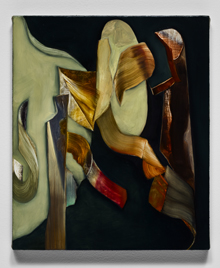
REVEALING ITS SECRETS ‘Untitled,’ oil on linen, 12 by 10 inches, by Lesley Vance, 2011. |
There are many different ways to talk about Lesley Vance's paintings, yet we don't really have the right words yet. Representation or abstraction? Illusionistic or flat? Old-masterly or contemporary? They are both, in each case. Vance is deeply shaped by the history of art yet produces works with a thoroughly contemporary sensibility. She is making an important contribution to the future of painting.Born in 1977 in Milwaukee, Vance now lives in Los Angeles and came to national attention through the 2010 Whitney Museum of American Art's Biennial Exhibition. Collectors and critics have responded passionately to her work, and all 17 modestly sized paintings and four small watercolors in her solo exhibition at the Bowdoin College Museum of Art are in private or corporate hands, including the collections of Steve Martin and Gary Garrels, a senior curator at the San Francisco Museum of Modern Art.
Looking at the paintings from a distance in the thankfully spacious installation, they have an almost uncanny bodily presence. Not able to make out details, they suggest shafts of light and the representation of something recognizable against dark backgrounds. The palette is evocative of Old Master paintings whose surfaces have aged with time. Stepping up closer, the paintings gradually reveal their secrets without ever disclosing them. It is difficult to verbally describe one of Vance's paintings, and that is one of their strengths.
In intensely complicated compositions, gestural brushwork exists next to trace-less geometric form, suggestive textures abut flat color, illusionistic passages are immediately denied again, edges assume immense importance. Background and form lie in one plane, denying any figure-ground relationship, yet often separate into layers when the pictorial space breaks open. Light and fiery color from within and underneath the paint burst forth from crevices between fields of subdued coloration, or escape in openings formed by enveloping paint manipulations. Similar to Roland Barthes's punctum, a personally touching, even wounding detail in a photograph, there are ecstatic paint incidents to be found in each work: the sweet surprise of a Vermeer-like blue, a certain twist of a brushstroke, a liquid pooling of texture, a patch of striated yellow that energizes the entire linen canvas. The paintings evidence an exuberant and quick light touch, with forms weaving in and out of space. Calligraphic, vaguely floral shapes intimate Vance's working process and methodology.
The artist has studied Renaissance painters like Hans Holbein the Younger, Modernists including Arthur Dove and Georgia O'Keefe, as well as still lifes of the 17th century, especially those of Francisco de Zurbarán. Her own early flower still lifes, which she showed images of at a public conversation at Bowdoin, transformed themselves into undulating shapes of strong color. The paintings on view start with a still life arrangement of natural and man-made objects that Vance photographs in a dark, box-like setting. The flattening and abstraction process continues through several drawings until she begins painting — abstraction thus evolving from representation. The Bowdoin show also includes recent watercolor and gouaches executed on non-absorbent paper, which leaves every brushstroke visible. These highly animated images supply their own draw, yet they are not as assertive as the paintings and ultimately lose in comparison.